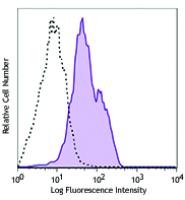-
Sign In
-

-
 Sony Biotechnology
Sony Biotechnology
-

-
 Sony Biotechnology
Sony Biotechnology
PE/Cy7 anti-mouse/human CD324 (E-Cadherin)
Antibodies Single
Sony
DECMA-1
Flow Cytometry
Rat IgG1, κ
Human
E-Cadherin extracellular domain
1336545
$121.00
Description
CD324, also known as E-cadherin, cadherin-1, CDH1, and UVO is a member of the cadherin superfamily. It is a calcium-dependent, transmembrane cell-cell adhesion glycoprotein composed of four extracellular cadherin repeats and a highly conserved cytoplasmic tail region. CD324 is widely expressed in epithelial cells in the colon, uterus, liver, keratinocytes, brain, heart, muscle, kidney, and pancreas as well as erythroid cells. CD324 functions as a cell adhesion molecule involved in development, bacterial pathogenesis, and tumor invasion. In bacterial pathogenesis, the ectodomain of CD324 mediates bacterial adhesion to mammalian cells, while the cytoplasmic domain is required for internalization. CD324 binds to the αEβ7 integrin to mediate cell adhesion and also interacts with a number of intracellular proteins including including erbin, ezrin, caspase-3, caspase-8, β-catenin, presenilin 1, and casein kinase II as well as other extracellular proteins including the EGF receptor.
Formulation
Phosphate-buffered solution, pH 7.2, containing 0.09% sodium azide.Recommended Usage
Each lot of this antibody is quality control tested by immunofluorescent staining with flow cytometric analysis. For flow cytometric staining, the suggested use of this reagent is ≤0.25 microg per million cells in 100 microL volume. It is recommended that the reagent be titrated for optimal performance for each application.
This product is subject to proprietary rights of Sirigen Inc. and is made and sold under license from Sirigen Inc. The purchase of this product conveys to the buyer a non-transferable right to use the purchased product for research purposes only. This product may not be resold or incorporated in any manner into another product for resale. Any use for therapeutics or diagnostics is strictly prohibited. This product is covered by U.S. Patent(s), pending patent applications and foreign equivalents.
References
1. Vestweber D, et al. 1985. EMBO. 4:3393. (IP, WB, FA)
2. Nakagawa M, et al. 2001. J. Cell Sci. 114:1829. (FA in canine cells)
3. Mohamet L, et al. 2010. PLoS ONE. 5:e12921. (IF)


